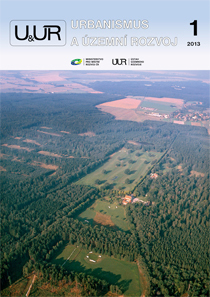
Documents of spatial analysis: Findings of consultations between Regional Offices and physical planning authorities, by Hana Máchová
According to the provisions of the 183/2006 Building Act, physical planning authorities are supposed to perform full updates of the documents of spatial analysis every two years. The deadline for the second full update of the documents of spatial analysis was 31 December 2012. The previous update, made in 2010, has undergone an external examination concluding in a recommendation to focus the second update on “specification of problems to be solved in the documents of spatial analysis” and “problem design”. This article is based on the experience which experts of the Ministry for Regional Development gained from consultations with Regional Offices and the physical planning authorities concerning the second full update of the documents of spatial analysis.
Results of the questionnaire survey of changes in the municipal housing stocks of selected towns and cities (2010, 2011), by Dana Chlupová, Marie Polešáková and Ludmila Rohrerová
In 2012 the Institute for Spatial Development again implemented a questionnaire survey for the Ministry for Regional Development aimed at the annual update and collection of data and investigations in five subjects: privatization of the municipal housing stock, shifts within the municipal housing stock, payments related to the use of municipal apartments, costs of the administration of the municipal housing stock, and additional data.
Planning in water management and physical planning, by Marie Polešáková
The objective of this article is a comparison and, consequently, coordination and combination of two systems of planning which both take into consideration the use of space and the public interest.
Difficulties with the assessment of sustainable development: From “I think that…” to a scientific approach and back again, by Dagmar Saktorová
Documents of spatial analysis are made by municipalties with extended powers for their territories and by Regions as stipulated by §§26-29 of the 183/2006 Building Act. An integral part of both municipal and regional documents is the analysis of sustainable spatial development. Municipalities have now finished the second update of the documents. This article assesses past developments and the methods used, based on the results of the oldest documents of spatial analysis, the first full update, and the current, second update. Expert reviews of selected analyses of sustainable development forming part of the first update were used a supportive arguments.
Intelligent cities, buildings and regions, by Vladimír Matuš
Our point of departure is the fact that the current relation of nature and mankind is unsustainable. It is not only an ethical or esthetical problem. It is a problem of the continuation or extinction of human life. We live on the very limits of what our planet can bear and we have no other option than to lay down a new covenant with the environment. All attempts to incorporate man and his activities into natural systems harmoniously have become a caricature of the original intention. Technology has created separate artificial ecologies that are incompatible with natural ecologies and we have to accept this. But recent technological developments give us hope that our living together with nature can be substantially changed. Advanced technology is our only hope but at the same time, all thinking about its role and about the future of mankind must proceed from knowledge of nature and its mechanisms. The concepts of “biomimicry” and “biome” are inspiring. Advanced distribution and communication networks bring us high living standards, but they do so at the price of higher vulnerability. Therefore we need to develop strategies that address this vulnerability and focus on autonomization of individual components and subsystems – all of which are parts of the concept of “resilient cities”. In the end we need to remember that any conclusions from our debates must be measured by their “utility”, that is, how they influence or help everyday routine activities.